Text
PROJECT FOUR
My Project Four is a progressive development painting series, representing a significant shift from my abstract artworks constructed for the previous project briefs. Considering the earlier project works as starting points, Project Four illustrates a variety of heritages in a realistic portrait style.

Canvas I

Canvas II

Canvas III

Canvas IV
Illustrative of Caucasian, Polynesian, Middle-Eastern and Asian cultures, my portrait series ‘Multi-Colour’ marries bold gestural painting with large scale mediums, producing a figurative, realistic artwork.

I found creating this substantial painting series explicitly challenging. Testing my attentiveness to the depth and detail, ‘Multi-Colour’ is evidence of a progression in skill and my individual painting style. Using all sizes of brushes and hues of acrylic paint, my body works as the active principle of each artwork.
Project Four represents my shift from the abstract to the figurative, small to large scale and neutral to ‘Multi-Colour’.
0 notes
Text
PROJECT THREE
The installation and display of my second project work, ‘Project Two’


0 notes
Text
PROJECT DEVELOPMENT (Cont.)
Continuing to progress through my portrait series, I began to develop a deeper awareness for the scale of the canvas and how realistic specific features needed to be.

Development of Canvas I & II
Experimenting in my works through width, line and texture I've been able to further establish my individual painting style. Referring to the essence of Project Four (’A Surprising Turn’), I’ve ‘turned’ back from abstract representation and am continuing to produce works for my series that visualise a realistic illustration of a face.
Time Lapse of Canvas II -
vimeo
During this series I've struggled with capturing distinctive traits and facial features that marry a specific heritage (i.e. Caucasian, Polynesian, etc.)

0 notes
Text
PROJECT TWO
My Project Two explicitly highlighted how a body can be the active principle of an artwork.
I drew reference from contemporary artist Jess Cochrane (Mixed Media Art / Painting / Photography) and fellow studio student that worked with brown butcher’s paper in Week One for the installation activity ‘Deck The Walls’. I set specific constraints for my partner to work with; including the length of paper used (1.5m x 95cm) and three interval times of one minute each. My Project Two is a documented exploration of gesture and scale found in a new way.
Project Development -
vimeo
Stage One, Pink Paint
vimeo
Stage Two, Blue Paint
vimeo
Stage Three, Yellow Paint
Through the documentation process it can be observed that my partner (i.e. artist) is blinded whilst painting. This was done to further push the element of gestural painting and highlight his body as the active principle driving the work.
Final Artwork -


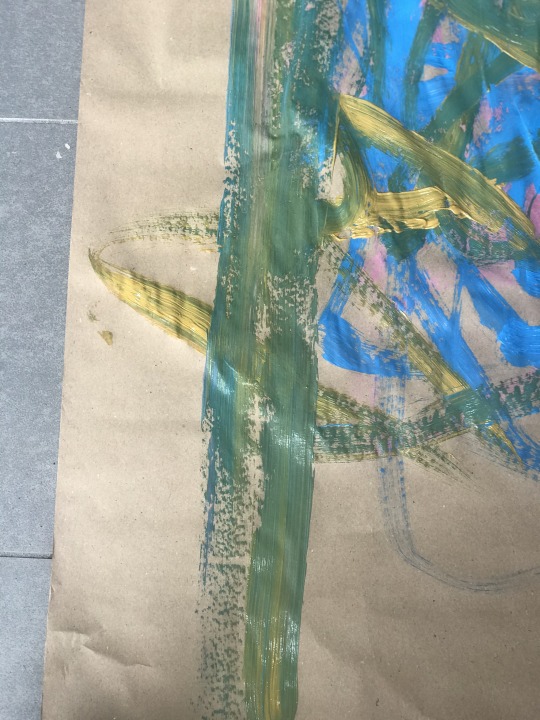
0 notes
Text
Week Nine
PEER REVIEW
My peer review was conducted on a studio member of Leah’s group, Tamara Davis; and her recent artwork ‘Macro-Micro’.
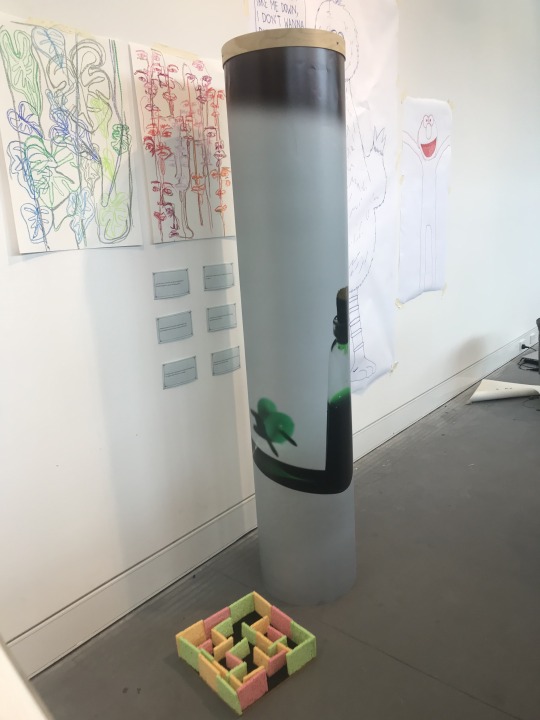
The artwork, titled “Macro-Micro” is consistent of two parts. The first is a small labyrinth, used as reference to Ancient Greek mythology and fear of being lost. The second, is a large sculpture combining photography and scale to evoke the same emotions of fear and isolation.
Representative of fear and the sense of being ‘lost’, the labyrinth Davis created was produced with pale coloured sponges in various sizes. This was purposely done to highlight the delicate, fragile state of our own bodies and minds when faced with individual fears. Juxtaposing the first element of the artwork in it’s size, the large photographic sculpture depicts a glass veil with a green liquid and a green thumb tack - all small sized objects blown into larger scale to further highlight the difference in size between the artworks two parts.
It is Tamara Davis’ intention to promote a sense on confusion when presented with this artwork. Seeing two unorthodox objects sitting together that share no recognisable or shared traits, creating the audience to question the emotion present in the work and in turn, the emotion within themselves. Davis has produced a juxtaposing installation, abstractly embodying fear and isolation.

Tamara Davis Installing ‘Macro-Micro’
0 notes
Text
PROJECT DEVELOPMENT
The following is a time lapse of my development of my first canvas from my Project Four painting series, “ Multi Colour ”
vimeo
0 notes
Text
Week Seven / Eight
CONSULTATION / PROJECT DEVELOPMENT
During week’s seven and eight, tutorial time was dedicated to consulting / developing artistic concepts for Project Four.
Initially my ideas for the theme of Project Four (”A Surprising Turn” ) were drawing based, exploring the explicitly ‘figurative’ visualisation of faces. Through extensive experimentation with figurative drawing in my journal and on a larger scale (A3 / A2 surfaces), I arrived at the decision to develop my painting style further with the use of a very large scale medium.
Choosing (later) to produce a portrait series, I became fascinated with large paintings depicting close up views of the subject’s face. Embodying the theme of Project Four, I decided I wanted to explore / challenge myself by illustrating faces of different cultures.. highlighting the anatomical, structural differences seen in the contrasting facial features.
Researching artists Nic Plowman and Anh Do, I found success in following a similar painting style on my large scale canvas’.
Development of Canvas I -

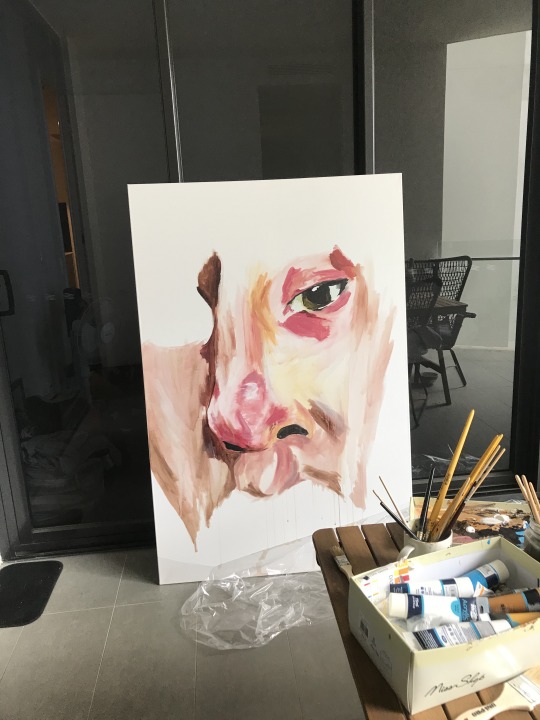
0 notes
Text
PROJECT ONE
My chosen artwork is my abstract sculptural piece, created to meet the criteria of this semester’s Project One. The construction process demanded a meticulous and delicate approach, experimenting with blunt, hard materials to create a simplistic plane for my artwork.
In light of the theme of “Work/s For a Body”, I decided to explore avenues that completely strayed from any literal or figurative concepts my thought process leant towards. Referencing the idea, I began the process of creating a sculptural piece with a ‘bodily’ focus.
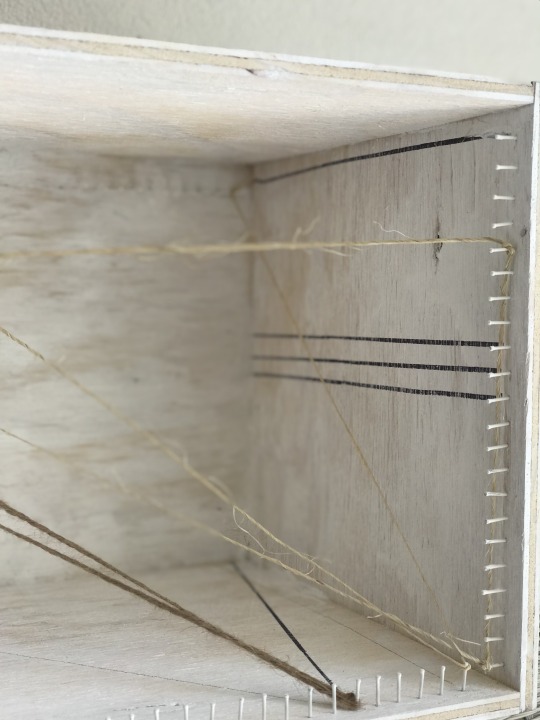
Following my documented thought process, I began testing physical materials that could act as an abstract representation of how a body works. Testing a diverse range of designs and concepts, I decided to embody the concept with a sculpture illustrative of wires connecting inside the brain. Taking shape in a blunt, geometric form, I constructed the ‘head’ of sculpture from measured boards of plywood, precisely fit, to create an open box shape. Detailing measured lengths of the plywood’s perimeter and the inside, I firmly positioned thin nails along these lengths. I proceeded to sheerly paint the inside of my piece white, to establish the sculpture’s interior and exterior. Consequently the painted interior provided a fresh plane to construct my connective, linear element.
After further exploration of connective materials (wire, fishing line, string, deconstructed twine) I installed two styles of drawn line and deconstructed twine, adjacent to individual nails to achieve the effect of a linear crossover.

Relative to my original idea, the outcome of my installation process was highly successful. The linear crossover of the twine reflected the connection of wires in the brain in an abstract format, whilst highlighting the connective property of the twine as a material. Acknowledging the process of composing my artwork, I continued to illustrate my ‘bodily’ focus.
0 notes
Text
Week Six - Tutorial Task
ACTING UP - EMBODIMENT GAMES
This week’s tutorial task was broken into two parts. Part One consisted of a warm - up inclusive game called ‘ZONES’. Primarily the game focussed on our class distributing ourselves through the self drawn circles (zones) and trying to stop the ‘boneless’ student from stepping into a vacant circle. Only ending when the zones student stepped into a circle, the game required group coordination and logical thinking.
Part Two was a collaborative performance activity, done in pairs. My partner Sophia Lee and I were allocated the term, ‘Tension’, and subsequently devised a performance piece. Aiming to embody the definition of ‘tension’ through our actions, we decided to produce a tense, sensory sound performance. Utilising the popular contemporary technique of ASMR (Autonomous Sensory Meridian Response).
After collecting the necessary equipment from the ELC in Z6, we begun whispering phrases / terms that created tension into our audio equipment. After practising and revising what content we’d use, we began our live performance artwork.
Live Performance Artwork -
vimeo
During our performance our composure wavered, and the humour of the phrases proved to be dominant. Reflecting on my first performance work infant of our studio class, I think composure and pushing the sounds of the chosen phrases / terms would be beneficial to the performance artwork.
0 notes
Text
Week Five - Tutorial Task
ART SLAM / CONSULTATIONS (Development of Project Works)
This week was a working consult within our allocated studio time. For myself, this majorly focussed on the development of my Project Works (one and two).
With my sculpture design documented in my journal, I worked on the progression of meaning and making that relative to the concept of “Work/s For a Body”. I chose to run with the progressive idea of ‘working connections in the body’ - consequently tying the theme and my sculpture for Project One together.
Production Process -

vimeo
Further into the individual work session I started the process of linking my performance artwork to the second project theme of “Body of Work/s For Something”.
Compiling phrases and sound techniques to create a performance artwork with my studio partner, Sophia Lee - we created a 27.52 minute video of ASMR -‘Autonomous Sensory Meridian Response’. Creating positive and negative stimulus within audiences bodies, responding to the sound.

Still within the refinement stage, I continue to individually work on ‘Project Two’.
0 notes
Text
Week Four - Tutorial Task
EMBODIED CAMERA
The task for week four’s tutorial demonstrated a focus on the body, and specifically it’s relationship with the camera. Our rules and constraints included the use a mobile phone camera or a camera to record the (30-60 second) footage exploring the relation between camera and body, and video-editing software.
Referring to the description of the camera being a ‘disembodied eye’, I immediately thought of the literal (human) eye, and light. As the camera is universally used to capture physical memories we’ve seen / experienced, and light can be used to alter or illuminate these experiences and how stein general. I believed the human eye and varying light were the perfect tools to convey the camera being an extension of the body.
I chose to record samples of three main pieces of footage to be used in the second phase of this task (Editing). Creating a sequence of gestural upper body movement, I wanted a blurred contrast between two clips of footage. Constructing the conclusion of my artwork, I imported and duplicated the recording zoomed in completely to my left eye. Speeding up the play time of these clips, I created a flickering light effect to further focus the movement of my eye.
Editing Process -



My video artwork illustrates a shot of my body from the top of shoulders upwards. Attempting to highlight the direction of vision, I move my head in each direction (including upwards) as my face is lit from the intense UV light to my left. I perform the actions of looking in different directions, I move slowly and gesturally so as to draw attention to my eyes. Towards the end of the video piece, I zoom in so the camera is focused completely on my left eye, as I change the degree of uv light my pupil slightly dilates and increases.
Final Artwork -
This week I experimented further with performance artwork, which surprised me after the previous task of ‘repeat after me’. I found the results editing and filming myself to be interesting and helpful as I could create footage and learn what I needed to involve to achieve the work / meaning I wanted to convey.
0 notes
Text
Week Three - Tutorial Task
REPEAT AFTER ME
This week’s task required an already prepared skill that can be taught to at least two other people. The task was broken into three time periods; the first, was a time constraint of 50 minutes in which I taught and learned the skills my group had prepared. The second, was to construct a short performance from the memory of learning our activities, with a maximum time of one minute. The third was a group review and consultation of our artwork.
My chosen skill to teach was blind drawing. The equipment brought to the task was two blank visual diaries and blindfolds - my two other group members drew an origami rabbit (previously learnt from a group member) for 45 seconds without vision.
Subject of the Drawings -

Skill Process -

Final Artwork -
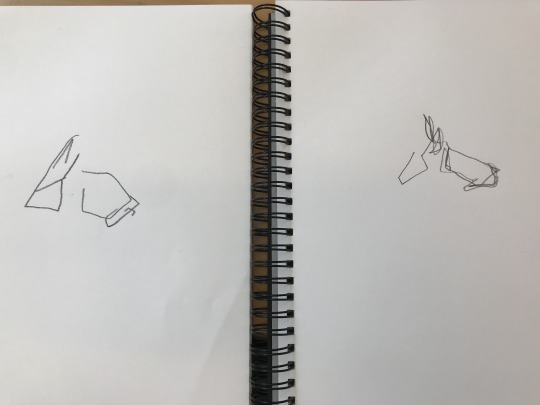
My learnt skills consisted of creating an origami rabbit and learning the months the year in French.
After the first time period had finished, our group moved to the second part of the task; our performance artwork.
Deciding to combine all three learnt skills and layer them to create a performance piece; we recorded ourselves blindly creating the origami rabbit whilst reciting the months of the year in French.
Performance Artwork -
Also documented is the result of our blind performance created rabbits:

Reflecting on this week’s task I have come to the conclusion I am not a performance artist, and do not enjoy watching myself after creating that style of artwork. However, I am happy with the result of the skills I have learnt and taught this week.
0 notes
Text
Week Two - Tutorial Task
INCISION / INDENTATION (WORKSHOP ONE)
This week’s tutorial focussed on incision and indentation. Held in the workshops, the task brought surface structure to the foreground by having us use different methods to work into the surface of plywood.
Open to a large array of tools in the Workshops, I was free to explore different methods of subtraction (incision and indentation). Unsure of how to start, I thought about what tools would produce the most interesting marks and incisions - and by default how gesture would effect the process and appearance of my surface.
Subtraction Process -
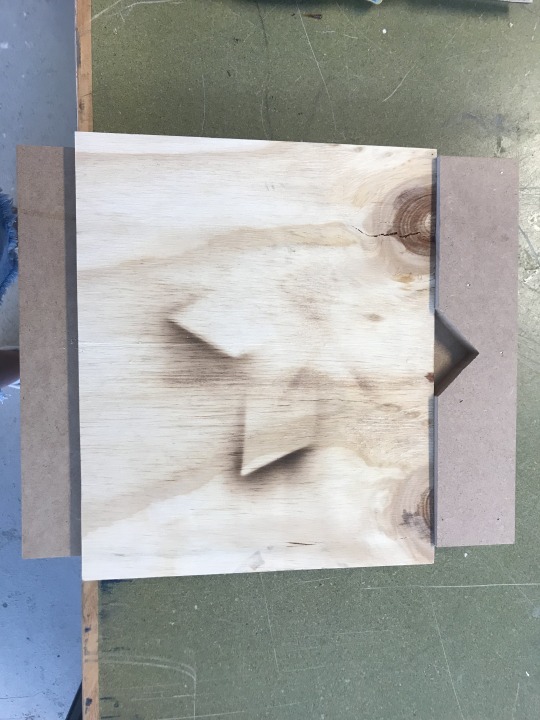
(original plywood surface)
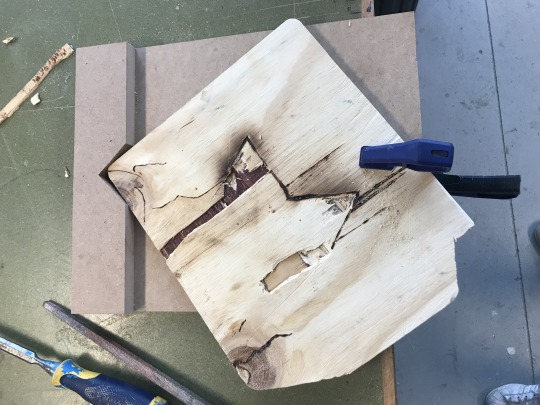
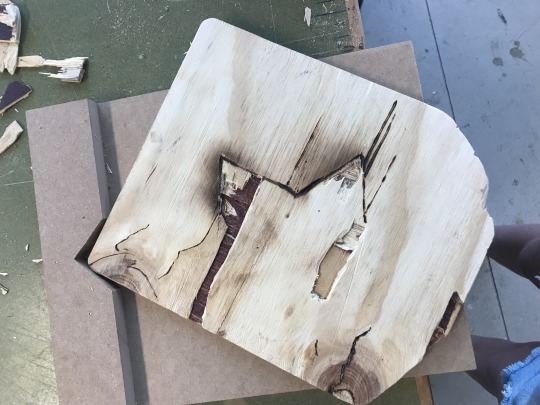
I began to play with the geometric shape and layering of the plywood, aiming to explore and expose the variety of layers within the surface.
Final Artwork -

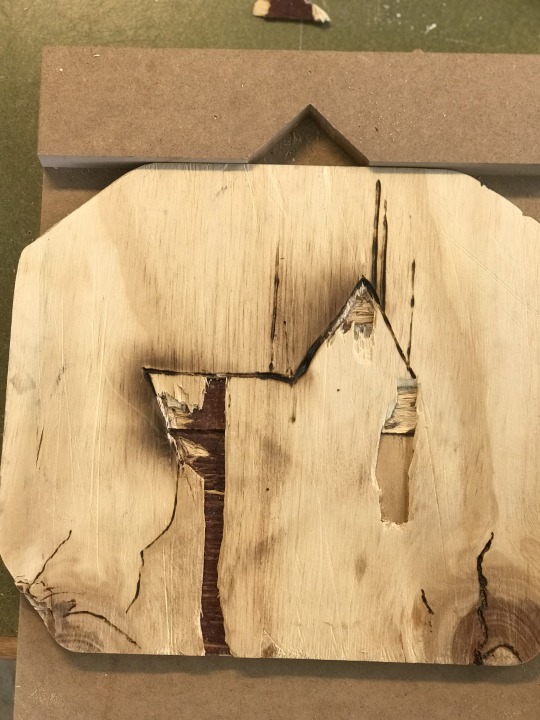
Reflecting on this week’s task, I feel as though I could have myself explore the properties of my surface more violently - as looking back at the work I get a sense of gestural refinement.
I would like push this work further by adding a cleaner perimeter (rounding the plywood edges) and stripping a lot more layers of plywood back.
0 notes
Text
Week One - Tutorial Task
DECK THE WALLS
This first week were instructed to produce an artwork relating to / or being a body of work to install on the Studio wall. Our tutorial aim was to cover the entire length and height of the studio’s wall.
Choosing to produce a group work, myself and two other class members began processing ideas for a ‘body’ work. Ideas ranged from the concept of continuous line, to drawing sculpture, literal body figures, to our final concept; an installation inclusive of our various body parts (external and internal). We were met with only a time constraint of two and a half hours, and the wall space we had to install it.
After our production process was finished, our group had constructed ten different ‘bodily’ pieces with our chosen material of wire. We were then pushed to think about the scale of our work, and how it would fit in relation to the rest of our tutorial groups work in regards to installation.
Installation Process -
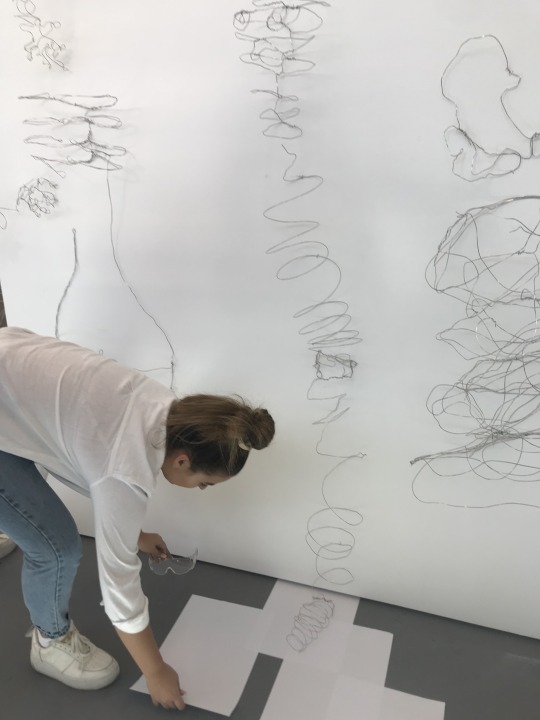
Installed on a blank area of white wall with a staple gun, our concept of continuous line rounded out our body of work, and the first tutorial task.
Final Artwork -
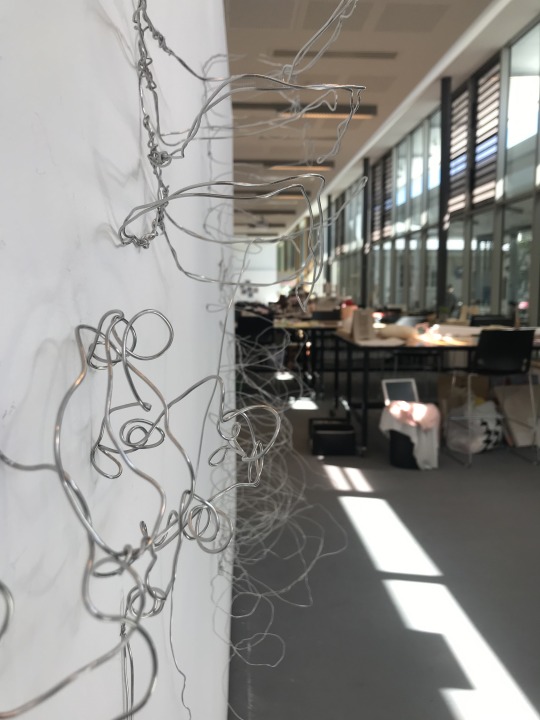

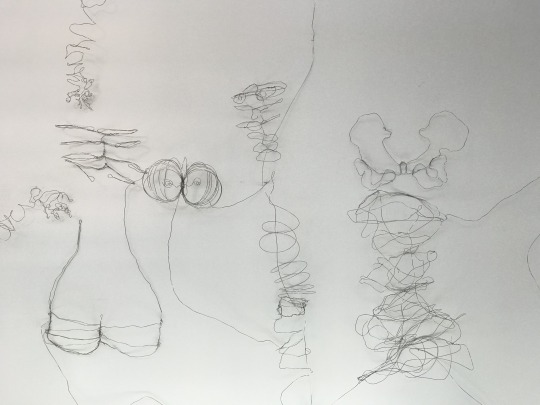
In reflection to this week’s task, I was challenged in areas of installation and physical production, Working with an extremely flexible material proved both successful and challenging. However, I believe the biggest challenge for this tutorial task was trying to stray from the ‘literal’ or ‘figurative’ form.
0 notes